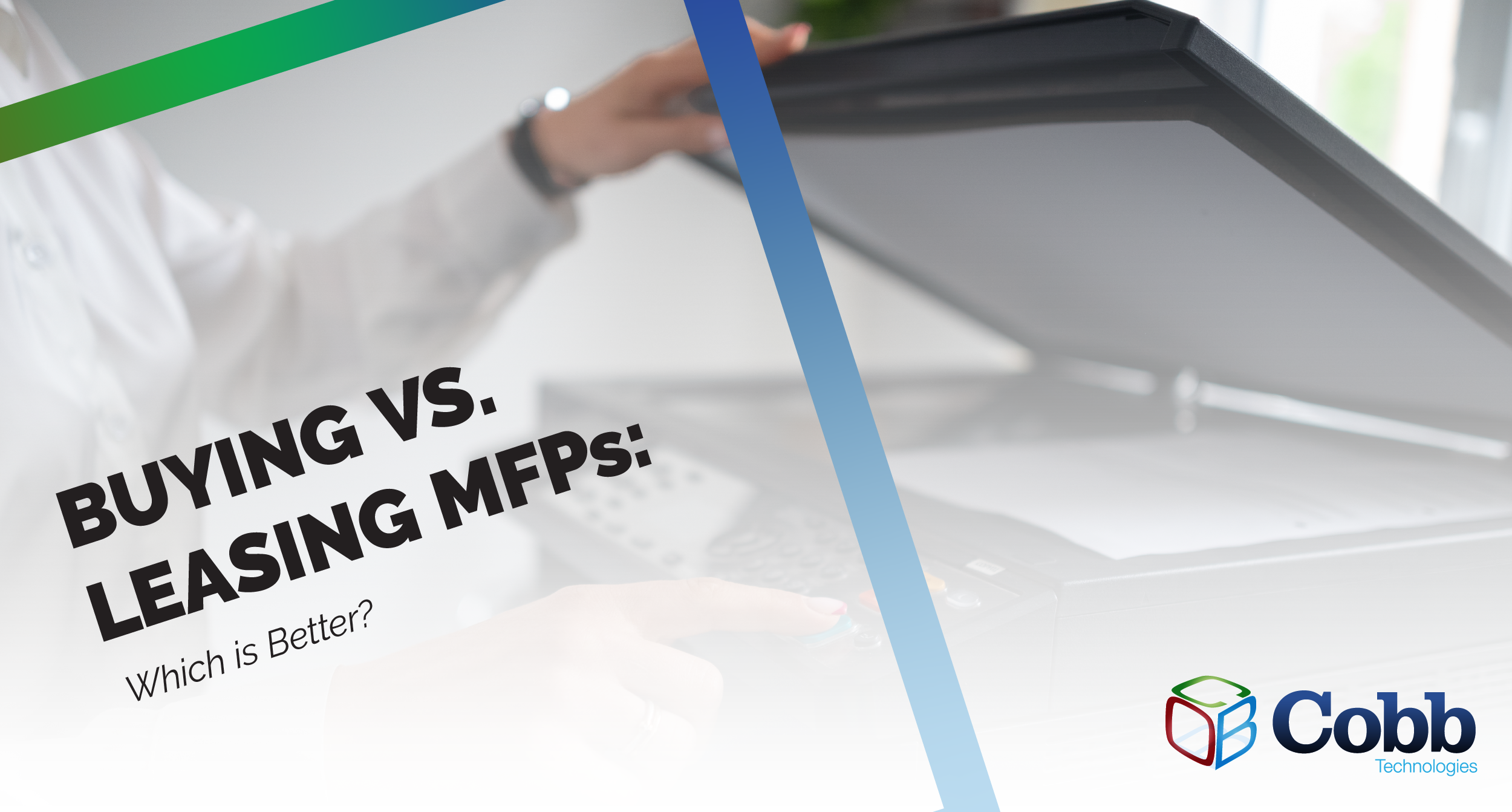3 min read
Building Culture That Works: Cobb Tech Named One of VA's Best
Cobb Technologies has been honored as one of the 2025 Best Places to Work in Virginia by Virginia Business and Best Companies Group. This prestigious...
3 min read
 Fred Harlan
Mar 12, 2020 9:15:56 AM
Fred Harlan
Mar 12, 2020 9:15:56 AM

Buying versus leasing — it can be a tough choice. Especially when it’s about an integral piece of your office infrastructure like a multi-function printer (MFP). Unfortunately, like most everything in this world, there isn’t one true answer for everyone — but there is a right answer for you.
Before you decide on purchasing or leasing your MFP, you’ll want to ask yourself the following questions:
These questions will help you lay the groundwork for making your decision. If you want to update and upgrade frequently, you'll want to choose leasing. A two or three-year lease will ultimately be lower than the total cost of an MFP, thus helping reduce your overall cost.
On the other hand, if you want a lower total cost and plan to use your MFP until the end of its lifecycle, you’ll want to buy your MFP.
Let’s get into the pros and cons of leasing and buying:
Reduction of Upfront Costs. By leasing equipment, there is typically no security deposit or upfront cost, making it easy to access equipment without significantly affecting cash flow or using capital on hand.
Tax Deductions. Many times, lease payments can be deducted as a business expense on your company’s tax returns, which will lower the overall cost of any leases.
Always Get The Latest Equipment. With your MFPs under a lease, you can easily upgrade to the latest technology each time you reach the end of your 36, 48, or 60-month lease agreement. Through leasing, you can keep your devices up-to-date and take advantage of any new features or improvements introduced with the latest equipment on the market.
Higher Long-Term Cost. Leasing equipment is nearly always more expensive in the long run than purchasing the equipment outright. The lease will have a small amount of interest, in order to protect the leasing company from risks on their end. This — over a matter of years — will end up adding some cost to your overall equipment expense.
The Equipment is Not Yours. If at the end of the lease, you decide you want to keep the equipment, you will need to purchase it at Fair Market Value ($1 buyout leases are an option, but tend to cost more overall than when compared to a fair market value lease, due to the higher monthly payment). Or, if you decide you do not want to lease from that company anymore, you will be responsible for the return of the equipment to the leasing company based on the directions that they will provide.
Obligation to the Lease Company. In most circumstances, if you choose you no longer want to lease equipment before the lease termination date, you will need to buyout the lease. Typically, this includes the total amount of all remaining payments and a small termination fee.
The Equipment Is Yours. The biggest advantage of purchasing your equipment is that the machines are now your own. You can choose to use the machines for as long as you’d like, except of course if parts come to yield; and with age, it becomes more likely that the needed parts for repairs will no longer be available. And when you do decide the equipment needs to be replaced, owning the machine allows you to keep the hard drive for security reasons, or you can donate your unit to a charity if you would like.
Depreciation. Typically equipment can be depreciated which will give your organization tax deductions where applicable.
High Up-Front Expense. This is the greatest disadvantage of purchasing equipment and might be a deterrent for small businesses with limited capital. Without spreading the cost over several years, the units you purchase will need to be paid for upfront, which can be a huge capital expense depending on the machines and features you need. Some companies may not be able to handle such a large upfront capital expense — but can afford a monthly operational expense instead.
Being Stuck with Old & Underperforming Equipment. When equipment is purchased, organizations usually run the copiers and printers for as long as they possibly can. Over time servicing the equipment will become much more expensive as parts are harder to find, and machines will typically begin to have many more issues, which can slow down the efficiency of employees who need to print frequently. Sometimes, if equipment is old enough, it will fall out of compatibility with new software, security measures, or compliance regulations. However, since your company owns the equipment, it can be hard to reinvest in more MFPs.
The decision between buying and leasing a multi-function printer depends on various factors unique to each business. There is no one-size-fits-all answer. By carefully weighing the pros and cons, and considering your business size and financial capabilities, you can make an informed decision that aligns with your operational goals. Depending on your business needs, buying could be the best option, or leasing could provide a better fit.
If you want to ensure your MFPs are up-to-date, at 100% efficiency, and provide the highest level of security, it's recommended to lease. If you plan on using your MFP until the end of its lifespan and want to save some money in the long run, purchasing an MFP may be the right answer for you.

3 min read
Cobb Technologies has been honored as one of the 2025 Best Places to Work in Virginia by Virginia Business and Best Companies Group. This prestigious...

5 min read
Cobb Technologies is honored to hold the SWaM (Small, Women-owned, and Minority-owned Business) certification, awarded by the Commonwealth of...

5 min read
Every year, thousands of Veterans transition from military service to civilian careers in Virginia, bringing invaluable skills and experiences to...